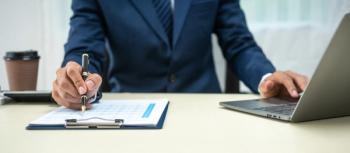
- Vol 32 No 3
- Volume 32
- Issue 3
If It Were Physical Pain, It Would Be Called Torture: A Story of Two Young Men
When did human rights become negotiable in the US? A commentary on dismantling and closure of federal and state mental hospitals.
[[{"type":"media","view_mode":"media_crop","fid":"33246","attributes":{"alt":"dismantling and closure of the federal and state mental hospitals","class":"media-image","id":"media_crop_212039536795","media_crop_h":"0","media_crop_image_style":"-1","media_crop_instance":"3579","media_crop_rotate":"0","media_crop_scale_h":"0","media_crop_scale_w":"0","media_crop_w":"0","media_crop_x":"0","media_crop_y":"0","style":"width: 265px; height: 191px;","title":"Photo credit: Dane County Deputy Sheriff Scott Lehmann","typeof":"foaf:Image"}}]]
COMMENTARY
When did human rights become negotiable in the US? When did human rights become a line item in a budget in the US? When did it become so difficult to simply do the right thing? Two recent newspaper articles portray how the seriously mentally ill have been systematically stripped of their human rights. By “human rights,” I mean the right to life and liberty.
The senator and his son
On November 1, 2014, The Washington Post ran an update on Virginia State Senator and former gubernatorial candidate,
He gets out of bed, where a piece of the shotgun he had taken apart in those last days of his son’s life is still hidden under the mattress. He goes outside to feed the animals, first the chickens in the yard and then the horses in the red-sided barn. He leads the blind thoroughbred outside with a bucket of feed, the same bucket he was holding when he saw Gus walking toward him-“Morning, Bud,” he said; “Morning,” Gus said, and began stabbing him-and then he goes back inside.
The dismantling and closure of the federal and state mental hospitals beginning in 1955 has resulted in an extreme shortage of programs and facilities for troubled persons such as Austin “Gus” Creeds to be evaluated; treated as long as necessary, ideally to a reasonable assurance of long-term stability; or kept indefinitely if necessary.2,3 That patients in some state mental hospitals were poorly treated, mistreated, or maltreated in the past does not mandate that a new public mental hospital system would do so.
Opponents of reinvigorating the public mental hospital system argue for community programs. However, community programs are always vulnerable to state and local budget cuts; have not been demonstrated to be consistently effective at early identification and management of young persons with emerging psychoses, especially if no crimes have been committed; and cannot ensure the safety of persons such as Gus Creeds and their potential victims-the victims often being people they love. Community programs are important but serve a different purpose in the continuum of care for the severely mentally ill.
The college student and the county jail
The second article addresses where many of the seriously mentally ill are now found-if they have committed a crime: in our county jails, or for more serious crimes, in our state prisons. The Capital Times, a Madison, Wisconsin, weekly, published the following description of how life can be for the seriously mentally ill in a county jail-that life often being in solitary confinement.4
In, “Boxed in: fighting for changes,”
But he admits that on May 10, 2013, he was disruptive, insolent and uncontrollable, so much so that when he was taken to the jail, deputies abandoned the booking process and put him into Segregation Cell 1, a stark 6-by-9 foot room with a concrete bed, a thin green mattress, a steel toilet and sink, and a metal door with a small slot for food. The overhead light remained on 24 hours a day. On his first day, he flooded his cell by clogging the toilet, was placed in a “suicide smock,” and later strapped by the torso, ankles and wrists to a “violent prisoner restraint chair.” He didn’t eat, his water supply was cut off and he slept only sporadically.
Two different outcomes- both disturbing
The main difference between Ian Olson (college student) and Gus Deeds (senator’s son) is that Mr Olson had committed a crime, while Mr Deeds had not. Mr Olson lived, but endured 4 days of “inhumane treatment,” a euphemism for “torture.” This was caused by roadblocks for immediately admitting such patients to the barely functioning nearby state mental hospital. Such roadblocks are economically driven.
Mr Deeds died because of the same roadblocks. Time had run out on a court order remanding him to treatment at a state psychiatric hospital. There were no beds available at the time the order was obtained, and the legal limit in 2013 for holding someone while awaiting a bed, presumably someone dangerous to themselves or others, in North Carolina, was 6 hours. There are civil liberties reasons for limiting the length of psychiatric holds. However, dangerousness should trump civil liberties-especially when the currency is measured in hours-and psychosis with dangerousness is neither life nor liberty and is measured in lifetimes. If Mr Deeds had committed a crime, perhaps he could have gone to solitary confinement at the county jail-experienced inhumane treatment there-and lived.
Inhumane treatment of the mentally ill-is this really who we are?
Sheriff Dave Mahoney in Wisconsin belongs in the same discussion as Dorothea Dix, a serious reformer who campaigned for the treatment of the seriously mentally ill in hospitals rather than have them languish in jails and prisons-often in solitary confinement-sometimes for years, occasionally for decades.5-7 The article referenced in The Capital Times includes a
For every young adult from a socially and economically advantaged family, presumably capable of finding appropriate services, like the Deeds and Olson families appear to be, how many dozens, or hundreds, or perhaps thousands of such patients from disadvantaged families are being subjected to similar treatment and worse? Or living under a bridge suppressing their psychological pain with drugs and alcohol?
Real leaders do not compromise with right and wrong. Such leaders do not delay when “inhumane treatment” is occurring. Leaders educate constituents and advocate for justice. Leaders do the right thing oblivious to the electoral calculus. Leaders do not consider “inhumane treatment” to be a line item in a budget. A reinvigorated public mental hospital system would save the lives of people like Gus Creeds and the daily pain his parents still experience, as well as obviate the need to use solitary confinement for people like Ian Olson. Everyone has the right to life and liberty.9
Disclosures:
Note to readers: As with all of our blogs, the opinions expressed in this commentary are solely those of the author. Comments not followed by full names and academic titles will either be removed or heavily monitored. –Psychiatric Times
*Members of the Research Committee, Group for the Advancement of Psychiatry also include Dr John Beahrs, Emeritus Professor of Psychiatry, Oregon Health Sciences University, Portland; Dr Barbara Hale-Richlen, the Hale-Richlen Center for Psychiatry, Milwaukee; Dr David Keith, Professor of Psychiatry and Behavioral Sciences, Upstate Medical Center, SUNY, Syracuse, NY; Dr Patrick Malone, Psychology Associates, Chapel Hill, NC; Dr Anup Sharma, Resident in Psychiatry, University of Pennsylvania, Philadelphia; Dr Alan Swann, Professor of Psychiatry and Behavioral Sciences, Baylor College of Medicine, Houston; and Dr Johan Verhulst, Emeritus Associate Professor of Psychiatry and Behavioral Sciences, University of Washington School of Medicine in Seattle, and Senior Advisor, The Kinsey Institute for Research in Sex, Gender, and Reproduction, Indiana University in Bloomington. Dr Margaret Cary, Assistant Professor, departments of psychiatry, and public health & preventive medicine, Oregon Health Sciences University, provided helpful comments on an earlier draft.
References:
1. McCrummen S.
2. Kramer DA, Verhulst J. Guns, violence, and mental health: did we close the state mental hospitals prematurely? Psychiatr Times. 2013;30(6):34-35.
3. Sacks O. The lost virtues of the asylum. New York Review of Books. 2009:50-52.
4. Elbow S. Boxed in: fighting for changes, Sheriff Dave Mahoney calls his own jail “inhumane.” Capital Times. November 5, 2014:18-20.
5. Rubinow DR. Out of sight, out of mind: mental illness behind bars. Am J Psychiatry. 2014;171:1041-1044.
6. Sisti DA, Segal AG, Emanuel EJ. Improving long-term psychiatric care: bring back the asylum. JAMA. 2015;313:243-244.
7. Kramer DA. Solitary confinement: it defines who we are. Psychiatr Times. July 18, 2014. http://www.psychiatrictimes.com/forensic-psychiatry/solitary-confinement-it-defines-who-we-are. Accessed February 6, 2015.
8. Milewski T.
9. Kramer DA. Jail proposal a defining issue for Dane County. Wisconsin State Journal. September 6, 2014:A9.
Articles in this issue
almost 11 years ago
Optimizing Care in a Team Setting: A Program for People With Schizophreniaalmost 11 years ago
Harnessing Social Media and Mobile Apps for Mental Healthalmost 11 years ago
Neuropsychiatric Sequelae of Stroke: Issues and Implications for Cliniciansalmost 11 years ago
Predicting, Assessing, and Treating Self-Harm in Adolescentsalmost 11 years ago
A Call to Arms to Understand and Treat Aggressive Behavioralmost 11 years ago
Dementia, Agitation, and Aggression: The Role of Electroconvulsive Therapyalmost 11 years ago
Gun Violence, Stigma, and Mental Illness: Clinical Implicationsalmost 11 years ago
Intermittent Explosive DisorderNewsletter
Receive trusted psychiatric news, expert analysis, and clinical insights — subscribe today to support your practice and your patients.

















